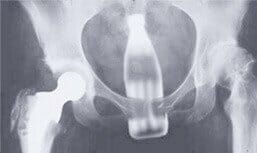HOW TO REMOVE A RECTAL FOREIGN BODY IN ONE EASY STEP (RARE IS THE PATIENT WHO EXPERIENCES THIS PROBLEM TWICE)
THE END
For those with a short attention span and a desire for immediate answers, here is the conclusion of this article: CONCLUSION: From a safety standpoint, the anal opening is best used for outgoing mail only. Insertion of a foreign body into the anus holds the potential for a painful and embarrassing injury.
WHY DO OBJECTS BECOME STUCK IN THE RECTUM?
Not uncommonly, a call is placed from the emergency room physician to the surgeon, requesting help extracting a rectal foreign body. In most cases, the uncomfortable and embarrassed patient has tried for hours or days to remove the offending object himself (rarely “herself”). Why did the foreign object become stuck in the first place?
The rectum is a muscular tube measuring 12–15 cm in length, with the sigmoid colon located proximally and the anus located distal to the rectum. To enter the rectum, an object must pass through the internal and external anal sphincters. Once inside the rectum, if the object travels beyond the coccyx, manual retrieval is difficult not only because it is out of reach, but because the object will be lodged proximal to the anterior curvature of the coccyx. The coccyx will now act as a check point, preventing egress of the solid foreign body. Even if the foreign body can be removed, repeated dilatation of the sphincteric complex holds the potential to damage the sphincteric muscle fibers, causing permanent difficulty with anal continence.
WHAT SORTS OF OBJECTS ARE INSERTED INTO THE RECTUM?

Objects can be inserted for a variety of reasons, including medical reasons such as enemas for disimpaction, for sexual pleasure, or during sexual assault. Bottles, light bulbs, dildos, vibrators, fruits or vegetables are just a few of the objects extracted from the colon or rectum (figure 1). Other, more unusual items include old radio vacuum tubes, coat hangers and enema installation kits filled with red wine instead of the standard enema fluid.
HOW TO REMOVE A RECTAL FOREIGN BODY. STEP ONE…CALL SOMEONE WITH EXPERIENCE.
In an asymptomatic, stable patient, after a thorough abdominal and anal exam, a careful and gentle proctosigmoidoscopy may be performed to both evaluate the colorectal lining and possibly visualize the foreign body. If there is no evidence of rectal perforation, an attempt to remove the object in the emergency department is appropriate.
If there are symptoms of rectal perforation, such as abdominal or pelvic pain or a rigid abdomen, urgent operative treatment is required. An elevated white blood cell count or free intraperitoneal air seen on plain x-ray also may lead to operative intervention.
Intravenous pain medication or conscious sedation at the bedside is usually needed to help the patient relax while an attempt is made to remove the object in the emergency room. The best position to extract the object is with the patient in the supine position and with the legs elevated in stirrups (lithotomy). If the object is proximal to the rectosigmoid junction, it may not be palpable during a digital exam. With the operator’s well-lubricated, gloved fingers placed slowly, gently and carefully into the rectum, abdominal pressure with the left hand is used to guide the object towards the rectum. If lucky, the surgeon may be able to grasp and extract the object. A Foley catheter inserted past the object can be used to release the negative pressure that has created a vacuum above the object. Ring forceps may be used if the object is visible through an anoscope, taking care not to pinch the rectal mucosa. Vacuum extraction can also be used if available. Extraction of the object with a sharp tenaculum should be avoided due to the possibility of rectal perforation. If extraction in the E.R. is successful, close follow-up is needed as there is always a risk of delayed sigmoid or rectal perforation secondary to pressure necrosis. The patient should be admitted for observation, or discharged home and seen in the office the next day for follow-up.
Overly aggressive extraction attempts should be avoided in the E.R. If all gentle attempts are unsuccessful, then the patient is brought to the operating room. Under general anesthesia, manual transanal extraction is attempted. If unsuccessful, exploratory laparotomy is needed.
With the abdomen open, the object is palpated in the sigmoid colon and is gently pushed or milked toward the rectum and extracted. In some stubborn cases, the colon must be opened to extract the object. Judgment is used to determine whether or not a temporary colostomy is required. In patients with rectal or sigmoid perforation and gross spillage of stool, a sigmoid resection and end colostomy is performed (Hartmann’s procedure). The colostomy can be reversed at a later date.
Rare is the patient who experiences a second retained foreign body. However, it is prudent to advise patients that situations giving rise to a retained colorectal foreign body are best avoided in the future.
